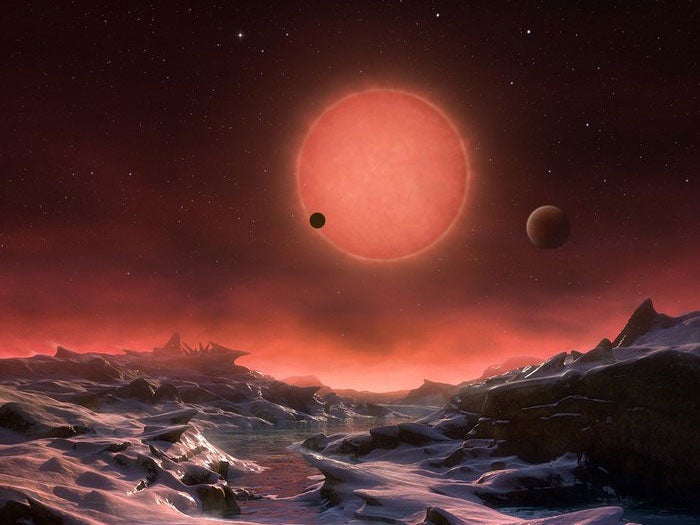The Independent's journalism is supported by our readers. When you purchase through links on our site, we may earn commission.
Discovery of life outside our solar system could be just 10 years away, astronomers say
Excitement is growing about two planets, relatively close to our solar system, that could be similar to Earth or Mars

The discovery of life outside our solar system could be just 10 years away, astronomers have said after they found further evidence suggesting two “precious” exoplanets are similar to Earth.
The planets, which orbit a star called Trappist-1 about 39 light-years away, are in the so-called Goldilocks Zone, suggesting the temperature is 'just right' for liquid water to exist – far enough away from the star that it does not evaporate, but close enough that it is not permanently frozen.
Their discovery was revealed in May, but interest has now ramped up with the announcement in the journal Nature that astronomers have found they are rocky planets like Mars, Venus or Earth, rather than gas giants like Jupiter or Saturn.
The next stage is to look for signs of gases that are only given off by living organisms, which can potentially be detected by analysing the light.
One of the researchers, Dr Julien de Wit, of the Massachusetts Institute of Technology, told The Independent: “These are the first planets that combine the three key properties we have been looking for for quite a long time: one, they are Earth-sized; two, temperature, they could have liquid water; and third, they are close enough and around the right type of star for us to actually check that out [whether they have life].
“That’s why these planets are really precious. We really hope we are going to find out more about these planets.
“We can say that these planets are rocky. Now the question is, what kind of atmosphere do they have?"
He said that astronomers should be able to find out more about the planets after the James Webb Space Telescope is launched in 2018.
“In five to 10 years we will be able to say if they are habitable, to check if they are the right temperature and with water,” he said.
“And then the next step forward is to assess whether they are inhabited… to look for traces of gas that can only be produced by life. This can be done in the next 10 to 25 years.
“If there are clear biomarkers, it’s feasible we could answer that question [whether there is life].”
However Dr de Wit cautioned it would “difficult to assess the level of intelligence” of any life on the planets.
“The biomass could be a huge amount of bacteria, for example,” he said.
And, whatever it is, it might well be radically different from life on Earth.
The planets are “tidally locked” to their star, meaning the sun would always be in the same position in the sky. One side of the planet would be in eternal daylight, the other in eternal night, much like our Moon.
And the star, an “ultracool dwarf”, produces mostly infrared light, which is outside the spectrum visible to humans. If astronauts were to land on one of the planets, they were barely be able to see with only a ‘dark’ red light.
“If there were to be life… it could be exotic,” Dr de Wit said.
However it is this kind of light that allows astronomers to make the observations that allowed them to discover the planets were rocky ones that could have an atmosphere like Earth, Venus or Mars.
If intelligent life with the same level of technology as we have exists on the planets, they would not be able to make the same observations about Earth.
The star was named after the Trappist telescope in Chile which first discovered the planetary system and the researchers are now trying to raise money to build more telescopes to speed up the search and also start scanning the skies in the northern hemisphere.
"It really is an exciting time," Dr de Wit said. "It's not unlikely we will start to tackle fundamental questions in the next 20 to 25 years."
Join our commenting forum
Join thought-provoking conversations, follow other Independent readers and see their replies
Comments